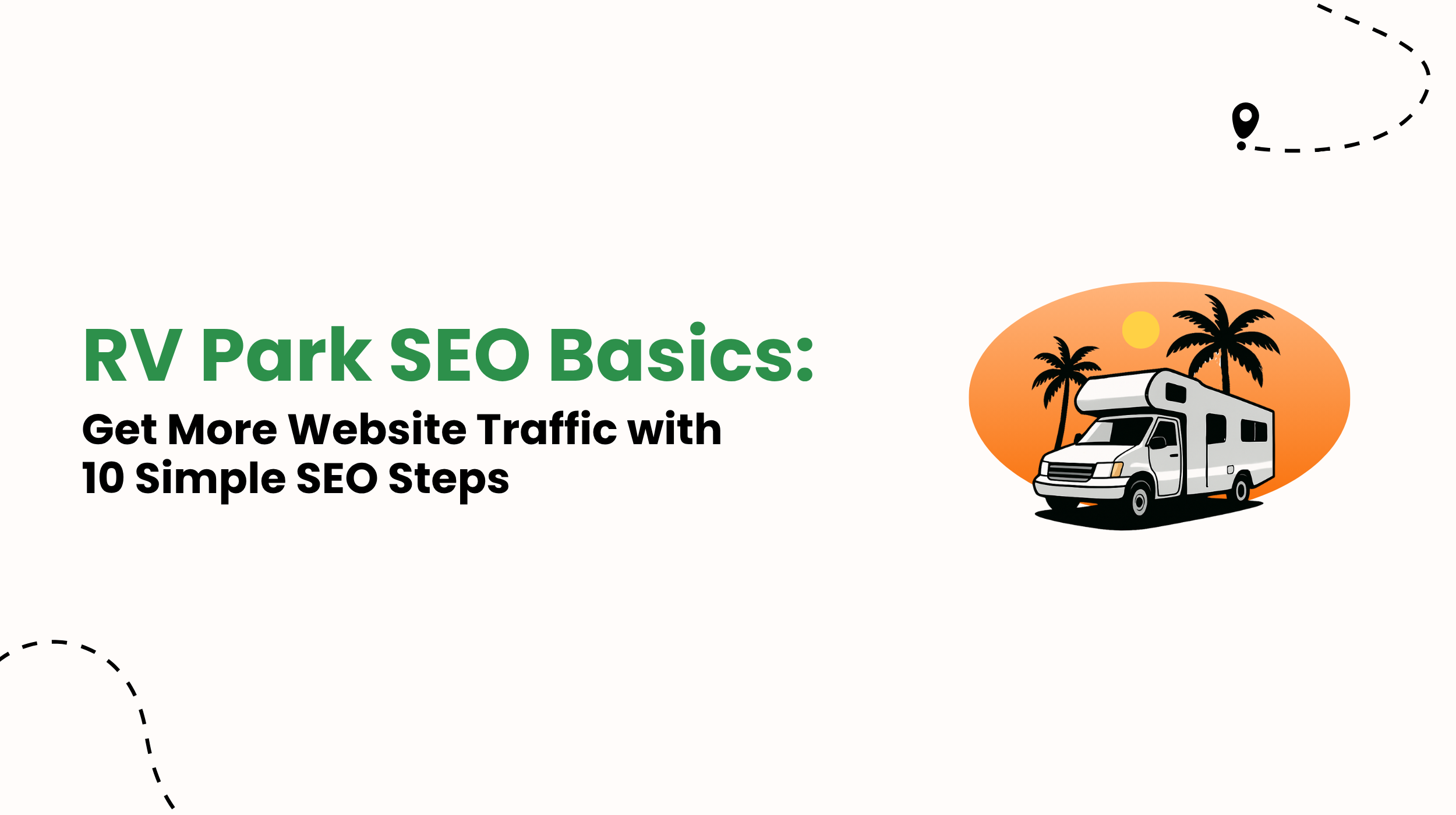To increase website traffic and bookings to your RV park, resort, or campground, make these 10 SEO basics a priority. Start with keyword research, then improve on-page SEO (title tags, meta descriptions, headers, internal linking), optimize your Google Business Profile, and create content that answers the real questions campers ask. These are practical, low-budget tactics that generate long-term traffic and visibility. Whether you’re doing it yourself or hiring a marketing partner to do it for you, these steps lay the groundwork for growth.
Why SEO Matters for RV Parks, Resorts, and Campgrounds
Whenever someone searches for ‘RV park near Moab’ or ‘best campground in Oregon,’ you want them to find your website on the first page of Google search results. But without strong SEO, it will be invisible.
SEO helps your website appear in front of people who search for the kind of experience you offer. It’s about getting more bookings from the right visitors.
This post will walk you through 10 basic (but powerful!) SEO steps tailored specifically for RV park operators. You don’t need to be a tech wizard to apply them, you just need a willingness to work on your site or simply pass these instructions to your web developer or agency.
1. Start with Keyword Research
SEO begins with understanding clearly what your audience is searching for.
Use these free tools:
- Google Keyword Planner
- Ubersuggest
- AnswerThePublic
Look for:
- Location-specific phrases (e.g. “RV park near Bryce Canyon”)
- Amenity-focused terms (e.g. “campgrounds with full hookups”)
- Activity-based queries (e.g. “campgrounds near hiking trails in Utah”)
Pick 5–10 main phrases to focus on, then sprinkle in related terms naturally.
2. Optimize Your Title Tags
Your title tag is the blue link people click on in Google Search page results. It’s also one of the strongest ranking factors.
Tips:
- Keep the title shorter than 60 characters
- Include your main keyword
- Make sure it’s compelling
Example:
Peaceful Pines RV Park – Quiet Campground Near Glacier National Park
3. Write Good Meta Descriptions
While meta descriptions don’t directly affect rankings, they influence click-through rates, especially on mobile devices.
Tips:
- Keep the description under 150 characters
- Include the main benefit
- End with a CTA
Example:
Enjoy full hookups, scenic views, and easy access to hiking trails. Book your stay today.
4. Use Header Tags to Organize Content
Header tags (H1, H2, H3) help users and search engines understand your content and it’s structure.
- Use one H1 per page (you only need to use it for your main title)
- Use H2s for main sections
- Use H3s for subpoints
This structure also makes it easier to achieve AI Overview exposure, as platforms like ChatGPT and Google’s SGE like structured answers.
5. Add Internal Links
Link from one page of your site to another. This keeps users engaged and helps search engines crawl your site.
Example:
From your homepage, link to:
- Your amenities page
- Local attractions guide
- Seasonal discounts page
Use descriptive anchor text like view our pet-friendly RV amenities rather than just click here.
6. Create Helpful, Evergreen Blog Content
Google loves fresh, useful content, particularly when it responds to specific questions.
Post ideas:
- “Top 5 Scenic Drives Near [Your Location]”
- “How to Prepare for Your First RV Trip”
- “Pet-Friendly RV Parks in [State]”
Aim for posts that are 800–1,200 words and include photos, maps, or embedded videos when possible.
One great example: Martrek Digital’s guide walks through SEO in a simplified format.
7. Make Sure Your Site Is Mobile-Friendly
More than 60% of your website traffic likely comes from mobile. If your site is slow or hard to use on a phone, people will bounce, and Google notices it.
Run your site through Google’s Mobile-Friendly Test and fix any issues it detects.
8. Claim and Optimize Your Google Business Profile
This is crucial for local SEO and showing up in Google Maps, and it’s a super-easy step.
Make sure your profile includes:
- Accurate name, address, and phone number (NAP)
- High-quality images of your park
- Business hours and seasonal dates
- A description that includes your top amenities and location keywords
Encourage happy guests to leave reviews, and make sure to reply to all of them, good or bad. What really matters is showing that the RV park is run by responsible people, not pretending bad reviews don’t exist.
For a great walkthrough, check out Whitespark’s guide.
9. Audit Your Website
Walk through your site as a customer. Ask yourself:
- Is navigation intuitive and easy?
- Can I find booking information quickly?
- Are there broken links or outdated info?
- Are all my page titles unique and relevant?
Use free tools like:
- Screaming Frog SEO Spider (free version)
- Sitebulb Lite
- Ahrefs Webmaster Tools
Fixing basic SEO issues can move the needle fast.
10. Track Results and Stay Consistent
SEO is a long game, but the payoff is real.
Implement tracking:
- Google Analytics: Tracks traffic and behavior
- Google Search Console: Tracks search performance and errors
Check in monthly to monitor growth. As rankings improve, so will traffic and bookings.
Final Thoughts
You need a plan, consistency, and a little bit of elbow grease (or a great partner who can do it for you) to improve your RV park’s SEO. It takes time, but then it works for you.
These 10 steps will give you a noticeable lift in visibility, especially if your competitors aren’t investing in SEO yet.
If you’re ready to go deeper or want help implementing these strategies, feel free to reach out to us or explore additional resources like:
